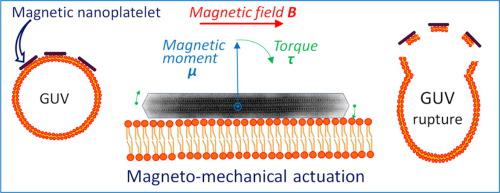Journal of Colloid and Interface Science ( IF 9.9 ) Pub Date : 2020-06-24 , DOI: 10.1016/j.jcis.2020.06.079 Tanja Goršak 1 , Mitja Drab 2 , Dejan Križaj 3 , Marko Jeran 4 , Julia Genova 5 , Slavko Kralj 6 , Darja Lisjak 1 , Veronika Kralj-Iglič 7 , Aleš Iglič 2 , Darko Makovec 6

|
Hypothesis
The magneto-mechanical actuation (MMA) of magnetic nanoparticles with a low-frequency alternating magnetic field (AMF) can be used to destroy cancer cells. So far, MMA was tested on different cells using different nanoparticles and different field characteristics, which makes comparisons and any generalizations about the results of MMA difficult. In this paper we propose the use of giant unilamellar vesicles (GUVs) as a simple model system to study the effect of MMA on a closed lipid bilayer membrane, i.e., a basic building block of any cell.
Experiments
The GUVs were exposed to barium-hexaferrite nanoplatelets (NPLs, ~50 nm wide and 3 nm thick) with unique magnetic properties dominated by a permanent magnetic moment that is perpendicular to the platelet, at different concentrations (1–50 µg/mL) and pH values (4.2–7.4) of the aqueous suspension. The GUVs were observed with an optical microscope while being exposed to a uniaxial AMF (3–100 Hz, 2.2–10.6 mT).
Findings
When the NPLs were electrostatically attached to the GUV membranes, the MMA induced cyclic fluctuations of the GUVs’ shape corresponding to the AMF frequency at the low NPL concentration (1 µm/mL), whereas the GUVs were bursting at the higher concentration (10 µg/mL). Theoretical considerations suggested that the bursting of the GUVs is a consequence of the local action of an assembly of several NPLs, rather than a collective effect of all the absorbed NPLs.
中文翻译:

六铁酸钡纳米片的电磁力学驱动,用于破坏磷脂膜。
假设
具有低频交变磁场(AMF)的磁性纳米粒子的磁机械致动(MMA)可用于破坏癌细胞。到目前为止,使用不同的纳米颗粒和不同的场特征在不同的细胞上测试了MMA,这使得对MMA结果的比较和任何推广都变得困难。在本文中,我们建议使用巨型单层囊泡(GUV)作为简单的模型系统来研究MMA对封闭脂质双层膜(即任何细胞的基本构件)的影响。
实验
GUVs暴露于六铁酸钡纳米血小板(NPL,约50 nm宽和3 nm厚),具有独特的磁性,并以与血小板垂直的永久磁矩为主,且浓度不同(1–50 µg / mL),水性悬浮液的pH值(4.2–7.4)。当暴露于单轴AMF(3–100 Hz,2.2–10.6 mT)时,用光学显微镜观察GUV。
发现
当NPL静电附着在GUV膜上时,在低NPL浓度(1 µm / mL)时,MMA诱导的GUV形状的周期性波动对应于AMF频率,而在较高浓度(10 µg)时GUV破裂/ mL)。理论上的考虑表明,GUV的破裂是几个不良贷款的集合体的局部作用的结果,而不是所有吸收的不良贷款的集体效应。


























 京公网安备 11010802027423号
京公网安备 11010802027423号